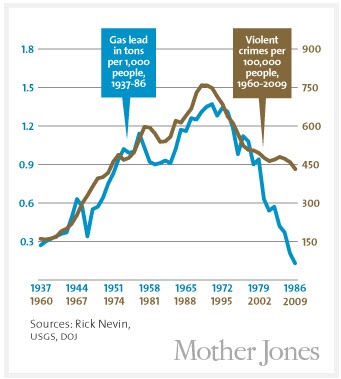Starting in the 1960s, America saw a huge increase in levels of violent crime that peaked in the early 1990s, then steadily declined, and continues to decline today. All kinds of theories have been promulgated to explain this peak and decline in crime, and plenty of politicians in the 1990s took credit for it. Lead emissions from automobiles explain 90 percent of the variation in violent crime in America. Toddlers who ingested high levels of lead in the ’40s and ’50s really were more likely to become violent criminals in the ’60s, ’70s, and ’80s.
And with that we have our molecule: tetraethyl lead, the gasoline additive invented by General Motors in the 1920s to prevent knocking and pinging in high-performance engines. As auto sales boomed after World War II, and drivers in powerful new cars increasingly asked service station attendants to “fill ‘er up with ethyl,” they were unwittingly creating a crime wave two decades later.
The use of lead pipes to carry water to wealthy neigh borhoods is claimed to be one major factor that contributed to the weakening and eventual destruction of the Roman Empire. At least we had the Science to discover our lead folly and correct it, even though much is to still be remediated. But the huge penal/judicial/police industrial complex budget justifications are threatened by such a simple crime source. Turns out criminologists were blaming the wrong Lead, when some accused the music of Led Zeppelin, among others.
borhoods is claimed to be one major factor that contributed to the weakening and eventual destruction of the Roman Empire. At least we had the Science to discover our lead folly and correct it, even though much is to still be remediated. But the huge penal/judicial/police industrial complex budget justifications are threatened by such a simple crime source. Turns out criminologists were blaming the wrong Lead, when some accused the music of Led Zeppelin, among others.
via America’s Real Criminal Element: Lead | Mother Jones.
Like this:
Like Loading...




 The FBI recently reported that homicides fell by 6.5% in the country’s biggest cities — those with populations of one million and up — through the first six months of 2007, and by about 1% across the U.S. Violent crime, overall, was off by about 2%. Even more astoundingly, New York City ended 2007 with 496 murders, the lowest number since 1963 [when statistics were first collected] — spurring New York magazine to ask the provocative question, “What would it take [for the murder rate] to go all the way to zero?” Chicago, bruised by enough scandal to unseat its superintendent of police, still managed to record just 443, the fewest since 1965 and the fourth straight year of logging under 500 murders.
The FBI recently reported that homicides fell by 6.5% in the country’s biggest cities — those with populations of one million and up — through the first six months of 2007, and by about 1% across the U.S. Violent crime, overall, was off by about 2%. Even more astoundingly, New York City ended 2007 with 496 murders, the lowest number since 1963 [when statistics were first collected] — spurring New York magazine to ask the provocative question, “What would it take [for the murder rate] to go all the way to zero?” Chicago, bruised by enough scandal to unseat its superintendent of police, still managed to record just 443, the fewest since 1965 and the fourth straight year of logging under 500 murders.